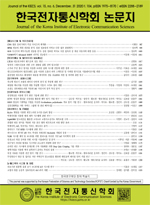초전도 전류제한소자를 적용한 DC 차단기의 동작 특성 분석
Analysis of Operation Characteristics of DC Circuit Breaker with Superconducting Current Limiting Element
- 한국전자통신학회
- 한국전자통신학회 논문지
- 제15권 제6호
-
2020.121069 - 1074 (6 pages)
-
DOI : 10.13067/JKIECS.2020.15.6.1069
- 43

DC에는 전류 영점이 없기 때문에 DC 차단기의 차단 동작시 아크가 발생한다. 이때 발생하는 아크의 크기에 따라 회로 차단기의 열화 또는 그리드에 치명적인 사고를 발생시킬 수 있다. 따라서 HVDC의 상용화에있어서 DC차단기의 차단기능의 안정성 확보는 대단히 중요한 부분이다. 본 연구에서는 DC 차단기의 성능과 신뢰성을 향상시키기 위해 초전도체가 적용된 LC 차단기를 제안 하였다. 초전도 LC 차단기는 기존 LC 차단기의 인덕터에 초전도 코일을 적용한 구조로 되었있다. 초기 고장 전류를 제한하는 것 외에도 고장 발생시 안정적인 전류 0점을 생성한다. 이를 확인하기 위해 EMTDC / PSCAD 프로그램을 통해 시뮬레이션을 수행하였다. 또한 초전도 LC 차단기는 일반 코일이 적용된 LC 차단기와의 동작 특성을 비교하였다. 그 결과 초전도 코일이있는 LC 회로 차단기는 일반 코일이있는 LC 회로 차단기에 비해 초기 고장 전류를 약 12kA 더 제한하는 것으로 나타났다. 이러한 결과를 통해서 DC 차단기의 아크 소화 시간을 약 0.16 초 단축시킬 수 있었고, 이를 통해 회로 차단기의 전기적 부담이 줄어듬을 확인할 수 있었다.
Since DC has no zero point, an arc occurs when the DC circuit breaker performs a shutdown operation. In this case, a fatal accident may occur in the circuit breaker or in the grid, depending on the magnitude of the arc. Therefore, the shutdown performance and the reliability of the circuit breaker are important in the commercialization of HVDC. In this study, a superconducting LC circuit breaker was proposed to improve the performance and the reliability of the DC circuit breaker. The superconducting LC circuit breaker applied a superconducting coil to the inductor of the existing LC circuit breaker. Other than limiting the initial fault current, it also creates a stable zero point in the event of a fault current. To verify this, simulation was performed through EMTDC/PSCAD. Furthermore, the superconducting LC circuit breaker was compared with the LC circuit breaker with a normal coil. As a result, it was found that the LC circuit breaker with the superconducting coil limited the initial fault current further by approximately 12 kA compared to the LC circuit breaker with a normal coil. This reduced the arc extinguish time by approximately 0.16 sec, thereby decreasing the elctrical power burden on the circuit breaker.
Ⅰ. Introduction
Ⅱ. Preparing a manuscript
Ⅲ. Experimental results
Ⅳ. Conclusion
References
(0)
(0)